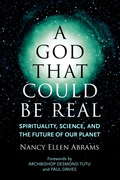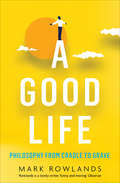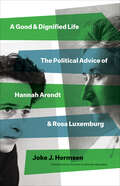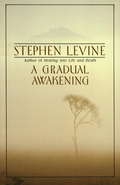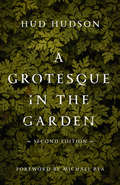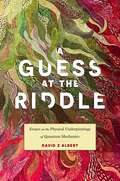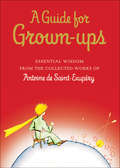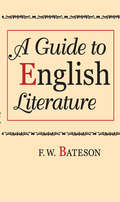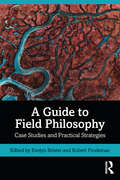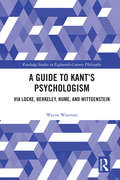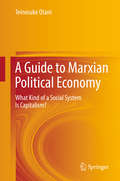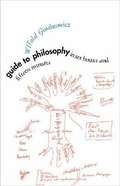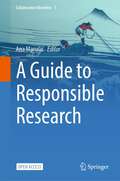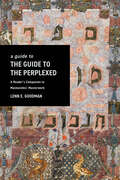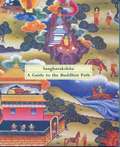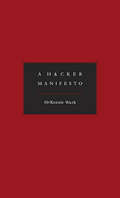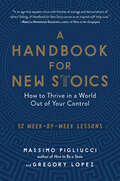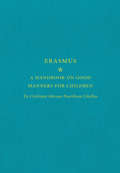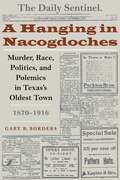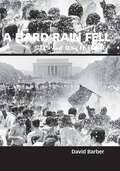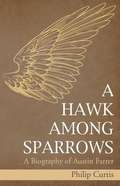- Table View
- List View
A God That Could Be Real
by Paul Davies Nancy Abrams Archbishop Desmond TutuA paradigm-shifting blend of science, religion, and philosophy for agnostic, spiritual-but-not-religious, and scientifically minded readers Many people are fed up with the way traditional religion alienates them: too easily it can perpetuate conflict, vilify science, and undermine reason. Nancy Abrams, a philosopher of science, lawyer, and lifelong atheist, is among them. And yet, when she turned to the recovery community to face a personal struggle, she found that imagining a higher power gave her a new freedom. Intellectually, this was quite surprising. Meanwhile her husband, famed astrophysicist Joel Primack, was helping create a new theory of the universe based on dark matter and dark energy, and Abrams was collaborating with him on two books that put the new scientific picture into a social and political context. She wondered, "Could anything actually exist in this strange new universe that is worthy of the name 'God?'" In A God That Could Be Real, Abrams explores a radically new way of thinking about God. She dismantles several common assumptions about God and shows why an omniscient, omnipotent God that created the universe and plans what happens is incompatible with science--but that this doesn't preclude a God that can comfort and empower us. Moving away from traditional arguments for God, Abrams finds something worthy of the name "God" in the new science of emergence: just as a complex ant hill emerges from the collective behavior of individually clueless ants, and just as the global economy emerges from the interactions of billions of individuals' choices, God, she argues, is an "emergent phenomenon" that arises from the staggering complexity of humanity's collective aspirations and is in dialogue with every individual. This God did not create the universe--it created the meaning of the universe. It's not universal--it's planetary. It can't change the world, but it helps us change the world. A God that could be real, Abrams shows us, is what humanity needs to inspire us to collectively cooperate to protect our warming planet and create a long-term civilization.From the Hardcover edition.
A Good Life: Philosophy from Cradle to Grave
by Mark RowlandsFramed by the story of a son finding his late father&’s journal, a meditation on love, meaning, and morality by the author of The Philosopher and the Wolf. Myshkin was born on a certain day and died on a certain day—and some things happened to him in between. These things presented him with ethical questions, and this book is a record of his attempt to answer those questions. Discovered in 2054 by his son after Myshkin's death in the Florida Keys, A Good Life is one man's reckoning with the life he has led and the choices he made. It is at once a philosophical handbook for living and a page-turning narrative, following one man's life (birth, death, education, religion, morality, illness, and so on) told through a philosophical lens. It is a riveting examination of the ethical questions we face, and the decisions we must make, and a defense of the idea that at the beating heart of morality we find love. Sometimes profoundly funny, sometimes deeply serious, A Good Life is as readable as a novel and as provocative as the best philosophy. It is the finest work to date by a charming and brilliant thinker. &“A lovely writer, funny and moving.&”—Observer
A Good and Dignified Life: The Political Advice of Hannah Arendt and Rosa Luxemburg (The Margellos World Republic of Letters)
by Joke J HermsenA timely and provocative essay about the parallel lives of Rosa Luxemburg and Hannah Arendt and their mission for a more humane society &“An intimate and timely meditation on dark times, Hermsen&’s illuminating essay offers readers a way to think with Hannah Arendt and Rosa Luxemburg about how to build a more humane world in common.&”—Samantha Rose Hill, author of Hannah Arendt Rosa Luxemburg (1871–1919) and Hannah Arendt (1906–1975) were critical Jewish mavericks who both suffered under violent political regimes and sought to reform systems of power. Although temporally separated by the Second World War and the rise of totalitarianism, they held in common strikingly similar convictions about freedom, human dignity, capitalism, democracy, and political commitment. In this powerful book, Joke J. Hermsen explores the lives and works of these two remarkable thinkers and the essential hope that emboldened them in the political struggle. Luxemburg and Arendt were spurred on by a restless love for the world and an unwavering belief in the possibility of new beginnings; for them, hope was an absolute prerequisite of resistance and a counterpoint to melancholy—a defense against despair that kept them attuned to what could be. Exploring the intertwined nature of philosophy and the active pursuit of justice, this is an urgent, courageous reminder to remain alert to the glimmers of hope in dark times.
A Gradual Awakening
by Stephen LevinePoet and meditation teacher Levine writes simply and gently about his own personal experiences with and insights into vipassana meditation. An inspiring book for anyone interested in deep personal growth.
A Great and Wretched City
by Mark JurdjevicLike many inhabitants of booming metropolises, Machiavelli alternated between love and hate for his native city. He often wrote scathing remarks about Florentine political myopia, corruption, and servitude, but also wrote about Florence with pride, patriotism, and confident hope of better times. Despite the alternating tones of sarcasm and despair he used to describe Florentine affairs, Machiavelli provided a stubbornly persistent sense that his city had all the materials and potential necessary for a wholesale, triumphant, and epochal political renewal. As he memorably put it, Florence was "truly a great and wretched city. " Mark Jurdjevic focuses on the Florentine dimension of Machiavelli's political thought, revealing new aspects of his republican convictions. Through "The Prince," "Discourses," correspondence, and, most substantially, "Florentine Histories," Jurdjevic examines Machiavelli's political career and relationships to the republic and the Medici. He shows that significant and as yet unrecognized aspects of Machiavelli's political thought were distinctly Florentine in inspiration, content, and purpose. From a new perspective and armed with new arguments, " A Great and Wretched City" reengages the venerable debate about Machiavelli's relationship to Renaissance republicanism. Dispelling the myth that Florentine politics offered Machiavelli only negative lessons, Jurdjevic argues that his contempt for the city's shortcomings was a direct function of his considerable estimation of its unrealized political potential.
A Grotesque in the Garden
by Hud HudsonAfter several millennia living as a lone sentinel in the Garden of Eden, the angel Tesque is contemplating leaving his post in rebellion against God. Meanwhile, in another time and place, a professor of mathematics isolates herself in remote Iceland as she finds herself increasingly at odds with society. The connection between these two characters? A letter, a sentient dog, and a deep-seated resistance to the demands of love. A Grotesque in the Garden is a philosophical tale that addresses some of theology&’s thorniest problems, including the questions of divinely permitted evil, divine hiddenness, and divine deception, couching them in narrative form for greater accessibility to students and general readers. While Hudson&’s story ultimately vindicates the virtue of obedience to God, it never shies away from critiques of troublesome theological positions. This second edition contains an appendix with commentary, discussion questions, and suggestions for further reading.
A Guerrilla Guide to Refusal
by Andrew CulpA field guide to a nonfascist life at the end of the world as we know itA Guerrilla Guide to Refusal is an unexpected approach to philosophy from a guerrilla-logic point of view. Harnessing critical theory to creatively reimagine counterinsurgency, guerrilla warfare, and interventions beyond the political mainstream, it takes us on a journey through anarchist infowar, queer outlaws, and black insurgency—through a subterranean network of communiques, military documents, contemporary art, political slogans, adversarial blogs, and captive media. In doing so, it provides powerful new insight into contemporary political movements that pose no demands, refuse labels, and offer no solutions.Written to both inspire and provoke, A Guerrilla Guide to Refusal urges us to think through the refusal to participate in politics as usual. Author Andrew Culp demonstrates how evasion can combatively deny the existing order its power. Focusing on punk cinema, anarchist pamphlets, feminist art projects, hacker manifestos, and guerrilla manuals, he foregrounds invisibility as a novel force of disruption. He draws on concepts of criminality, fugitivity, and anonymity to bring a more nuanced understanding of how power makes things—and people—visible.The book&’s unique format is that of a theoretical manual, comprising freestanding segments instead of blueprints. Poised to reach beyond the academy into activist circles, this potent theory-in-action intervention forces us to reconsider the terrain upon which our struggles against patriarchy, anti-Blackness, capitalism, and the state operate.
A Guess at the Riddle: Essays on the Physical Underpinnings of Quantum Mechanics
by David Z AlbertFrom the celebrated author of Quantum Mechanics and Experience comes an original and exhilarating attempt at making sense of the strange laws of quantum mechanics.A century ago, a brilliant circle of physicists around Niels Bohr argued that the search for an objective, realistic, and mechanical picture of the inner workings of the atom—the kind of picture that had previously been an ideal of classical physics—was doomed to fail. Today, there is widespread agreement among philosophers and physicists that those arguments were wrong. However, the question of what that picture might look like, and how it might fit into a comprehensive picture of physical reality, remains unsettled.In A Guess at the Riddle, philosopher David Z Albert argues that the distinctively strange features of quantum mechanics begin to make sense once we conceive of the wave function, vibrating and evolving in high-dimensional space, as the concrete, fundamental physical “stuff” of the universe. Starting with simple mechanical models, Albert methodically constructs the defining features of quantum mechanics from scratch. He shows how the entire history of our familiar, three-dimensional universe can be discerned in the wave function’s intricate pattern of ripples and whorls. A major new work in the foundations of physics, A Guess at the Riddle is poised to transform our understanding of the basic architecture of the universe.
A Guide for Grown-ups: Essential Wisdom from the Collected Works of Antoine de Saint-Exupéry (The\little Prince Ser.)
by Antoine de Saint-ExupéryA delightful collection of inspiring quotations from the mind of Antoine de Saint- Exupéry, author of The Little Prince.&“One sees clearly only with the heart. Anything essential is invisible to the eyes.&”For more than sixty years, this insight from The Little Prince has been quoted in more than 130 languages by fans around the world. Now, for the first time, quotations from the collected works and letters of Antoine de Saint-Exupéry are presented in a charming gift edition. Six chapters—&“Happiness,&” &“Friendship,&” &“Responsibility,&” &“Fortitude,&” &“Love,&” and &“What Is Essential&”—offer inspirational and thought-provoking words about the subjects held most dear by the author. A perfect gift for graduates—or for anyone who wants gentle guidance.
A Guide to English Literature
by F. W. BatesonAt first glance A Guide to English Literature may seem to be no more than a short bibliography of English literature with perhaps rather more extensive--and certainly more outspoken--comments on the principal editions, commentaries, biographies, and critical works than bibliographies usually provide. But it is something more: this guide contains long ""inter-chapters"" that provide reinterpretations of the principal periods of English literature in the light of modern research, as well as two final sections summarizing in unusual detail the literary criticism that exists in English and recent scholarship in the field. The purpose of this book, then, is to provide the reader with convenient access to a disciplined study of the texts themselves.This guide proposes itself as a new kind of literary history. The conventional history of literature has often tended to become a substitute for the reading of the literature it describes: the better the history, the greater the temptation to substitute it. The present combination of reading lists and inter-chapters cannot be a substitute for anything else. Meaningless as literature in themselves, they nevertheless provide the necessary preliminary information to meaningful reading. Since oddities of arrangement derive from these assumptions, the authors are not arranged alphabetically. Instead there are chronological compartments--with the divisions circa 1500, 1650, and 1800--in which authors succeed each other in the order of their births.This pioneering handbook is primarily a bibliographical laborsaving device. It is meant mostly for students and the general reader in that it stops where original research by the reader is expected to begin. However, the last chapter on literary scholarship is devoted specifically to the research specialist and provides indispensable equipment for the reader. There is also a general section on literary criticism which will be of use to all.
A Guide to Field Philosophy: Case Studies and Practical Strategies
by Robert Frodeman Evelyn BristerPhilosophers increasingly engage in practical work with other disciplines and the world at large. This volume draws together the lessons learned from this work—including philosophers’ contributions to scientific research projects, consultations on matters of policy, and expertise provided to government agencies and non-profits—on how to effectively practice philosophy. Its 22 case studies are organized into five sections: I Collaboration and Communication II Policymaking and the Public Sphere III Fieldwork in the Academy IV Fieldwork in the Professions V Changing Philosophical Practice Together, these essays provide a practical, how-to guide for doing philosophy in the field—how to find problems that can benefit from philosophical contributions, effectively collaborate with other professionals and community members, make fieldwork a positive part of a philosophical career, and anticipate and negotiate the sorts of unanticipated problems that crop up in direct public engagement. Key features: Gives specific advice on how to integrate philosophy with outside groups. Offers examples from working with the public and private sectors, community organizations, and academic groups. Provides lessons learned, often summarized at the end of chapters, for how to practice philosophy in the field.
A Guide to Kant’s Psychologism: via Locke, Berkeley, Hume, and Wittgenstein (Routledge Studies in Eighteenth-Century Philosophy)
by Wayne WaxmanThis book presents an interpretation of Kant’s Critique of Pure Reason as a priori psychologism. It groups Kant’s philosophy together with those of the British empiricists—Locke, Berkeley, and Hume—in a single line of psychologistic succession and offers a clear explanation of how Kant’s psychologism differs from psychology and idealism. The book reconciles Kant’s philosophy with subsequent developments in science and mathematics, including post-Fregean mathematical logic, non-Euclidean geometry, and both relativity and quantum theory. It also relates Kant’s psychologism to Wittgenstein’s later conception of language. Finally, the author reveals the ways in which Kant’s philosophy dovetails with contemporary scientific theorizing about the natural phenomenon of consciousness and its place in nature. This book will be of interest to Kant scholars and historians of philosophy working on the British empiricists.
A Guide to Marxian Political Economy: What Kind Of A Social System Is Capitalism?
by Teinosuke OtaniThis textbook offers a comprehensive guide to the systematic structure of capitalism, while at the same time introducing readers to all three volumes of Marx’s Capital. Based on his extensive expertise on Marx’s critique of political economy, the author reveals the specific structure of production in capitalist societies and explicates what sets this system apart from other modes of production. Marx’s political economy is explained in a systematic and easy-to-understand manner, using numerous illustrative diagrams to complement the text. This textbook will appeal to all students and scholars looking for a more comprehensive, systematic and theoretical explanation of capitalism, equipping them with a solid theoretical understanding of its core structure.
A Guide to NIP Theories
by Pierre SimonThe study of NIP theories has received much attention from model theorists in the last decade, fuelled by applications to o-minimal structures and valued fields. This book, the first to be written on NIP theories, is an introduction to the subject that will appeal to anyone interested in model theory: graduate students and researchers in the field, as well as those in nearby areas such as combinatorics and algebraic geometry. Without dwelling on any one particular topic, it covers all of the basic notions and gives the reader the tools needed to pursue research in this area. An effort has been made in each chapter to give a concise and elegant path to the main results and to stress the most useful ideas. Particular emphasis is put on honest definitions, handling of indiscernible sequences and measures. The relevant material from other fields of mathematics is made accessible to the logician.
A Guide to Philosophy in Six Hours and Fifteen Minutes
by Witold Gombrowicz Benjamin IvryWitold Gombrowicz (1904-1969), novelist, essayist, and playwright, was one of the most important Polish writers of the twentieth century. A candidate for the Nobel Prize in Literature in 1968, he was described by Milan Kundera as "one of the great novelists of our century" and by John Updike as "one of the profoundest of the late moderns. " Gombrowicz's works were considered scandalous and subversive by the ruling powers in Poland and were banned for nearly forty years. He spent his last years in France teaching philosophy; this book is a series of reflections based on his lectures. Gombrowicz discusses Kant, Hegel, Schopenhauer, Kierkegaard, Sartre, and Heidegger in six "one-hour" essays and addresses Marxism in a shorter "fifteen-minute" piece. The text-a small literary gem full of sardonic wit, brilliant insights, and provocative criticism-constructs the philosophical lineage of his work.
A Guide to Responsible Research (Collaborative Bioethics #1)
by Ana MarušićThis Open Access book is a guide to good, responsible research at each step of the process of research discovery, so that a researcher at the beginning of a scientific career has a clear pathway to doing good research and producing reliable results.The textbook will give context to the practices described in the European Code of Conduct for Research Integrity, guided by the fundamental principles or research integrity – reliability, honesty, respect, and accountability. Although we base the book on the European Code, the principles are the same in the global research community, such as those outlined in Fostering Integrity in Research from the US National Academies; Engineering and Medicine. The chapters in the book follow good research practices, give practical advice and address basic principles. In this way, the book is applicable to different research fields. It directs readers to various sources for further and updated information, particularly drawing from the resources available at The Embassy of Good Science, the European platform for research integrity and ethics.
A Guide to The Guide to the Perplexed: A Reader’s Companion to Maimonides’ Masterwork
by Lenn GoodmanIn this volume, noted philosopher Lenn E. Goodman shares the insights gained over a lifetime of pondering the meaning and purpose of Maimonides' celebrated Guide to the Perplexed. Written in the late twelfth century, Maimonides' Guide aims to help religiously committed readers who are alive to the challenges posed by reason and the natural sciences to biblical and rabbinic tradition. Keyed to the new translation and commentary by Lenn E. Goodman and Phillip I. Lieberman, this volume follows Maimonides' life and learning and delves into the text of the Guide, clearly explaining just what Maimonides means by identifying the Talmudic Ma'aseh Bereshit and Ma'aseh Merkavah with physics and metaphysics (to Maimonides, biblical cosmology and theology). Exploring Maimonides' treatments of revelation, religious practice and experience, law and ritual, the problem of evil, and the rational purposes of the commandments, this guide to the Guide explains the tactics Maimonides deployed to ensure that readers not get in over their heads when venturing into philosophical deep waters.
A Guide to the Buddhist Path
by SangharakshitaAn accessible and enlightening introduction to the basics of Buddhism, based on the numerous lectures given by Sangharakshita. This edition is of the corrected, second edition.
A Hacker Manifesto
by McKenzie WarkA double is haunting the world—the double of abstraction, the virtual reality of information, programming or poetry, math or music, curves or colorings upon which the fortunes of states and armies, companies and communities now depend. The bold aim of this book is to make manifest the origins, purpose, and interests of the emerging class responsible for making this new world—for producing the new concepts, new perceptions, and new sensations out of the stuff of raw data. A Hacker Manifesto deftly defines the fraught territory between the ever more strident demands by drug and media companies for protection of their patents and copyrights and the pervasive popular culture of file sharing and pirating. This vexed ground, the realm of so-called “intellectual property,” gives rise to a whole new kind of class conflict, one that pits the creators of information—the hacker class of researchers and authors, artists and biologists, chemists and musicians, philosophers and programmers—against a possessing class who would monopolize what the hacker produces. Drawing in equal measure on Guy Debord and Gilles Deleuze, A Hacker Manifesto offers a systematic restatement of Marxist thought for the age of cyberspace and globalization. In the widespread revolt against commodified information, McKenzie Wark sees a utopian promise, beyond the property form, and a new progressive class, the hacker class, who voice a shared interest in a new information commons.
A Handbook for New Stoics: How To Thrive In A World Out Of Your Control--52 Week-by-week Lessons
by Massimo Pigliucci Gregory LopezA pragmatic philosophy more popular than ever—here are 52 ancient lessons to help you overcome adversity and find tranquility in the modern world Stress often comes from situations that are beyond our control—such as preparing for a meeting, waiting for test results, or arguing with a loved one. But we can control our response to these everyday tensions—through the wisdom and practice of Stoicism. Stoicism is an ancient pragmatic philosophy that teaches us to step back, gain perspective, and act with intention. In A Handbook for New Stoics, renowned philosopher Massimo Pigliucci and seasoned practitioner Gregory Lopez provide 52 week-by-week lessons to help us apply timeless Stoic teachings to modern life. Whether you’re already familiar with Seneca and Marcus Aurelius, or you’re entirely new to Stoicism, this handbook will help you embrace challenges, thrive under pressure, and discover the good life!
A Handbook of Wisdom
by Jennifer Jordan Robert J. SternbergAt a time when poor choices are being made by notably intelligent and powerful individuals, this book analyzes a form of reasoning and decision-making that is not only productive and prudent, but serves as well a beneficial purpose for society. A Handbook of Wisdom includes contributions from some of the most prominent scholars in the field of wisdom research. Written from multiple perspectives, including psychology, philosophy, and religion, this book gives the reader an in-depth understanding of wisdom's past, present, and possible future direction within literature, science, and society.
A Handbook on Good Manners for Children: De Civilitate Morum Puerilium Libellus
by ErasmusWhen did you last tell your children to put their hand over their mouth when they yawn? When did you last suggest that when they are introduced to someone they should shake hands firmly and look them in the eye? Do you suggest that they should wait until everyone is served before they eat rather than hoover up the best bit for themselves? Do you demand that your young daughter dress decorously lest she elicit outraged looks? Do you think that the children of today have disgraceful manners? Unlike, of course, when you were young ... Well, that's certainly what Erasmus of Rotterdam thought in 1530 when he published De Civilitate Morum Puerilium: A Handbook on Good Manners for Children. He felt that learning good manners was crucial to a child's upbringing, and that the uncouth and ill-disciplined behaviour around him demanded a new kind of book. After all, as William of Wykeham memorably said in the 1350s, 'Manners maketh man'. A Handbook on Good Manners for Children is considered to be the first treatise in Western Europe on the moral and practical education of children. It was a massive bestseller - indeed the biggest-selling book of the sixteenth century - going into 130 editions over 300 years and being translated into 22 languages within ten years of its publication. In it, Erasmus concerns himself with matters such as how to dress, how to behave at table, how to converse with one's elders and contemporaries, how to address the opposite sex and much else. For example: Table Manners 'It's just as rude to lick greasy fingers as it is to wipe them on your clothing, Use a cloth or napkin instead.''Some people, no sooner than they've sat down, immediately stick their hands into the dishes of food. This is the manner of wolves.' 'Making a raucous noise or shrieking intentionally when you sneeze, or showing off by carrying on sneezing on purpose, is very ill-mannered.''To fidget around in your seat, and to settle first on one buttock and then the next, gives the impression that you are repeatedly farting, or trying to fart.' The advice is as relevant today as it was 500 years ago.
A Hanging in Nacogdoches: Murder, Race, Politics, and Polemics in Texas's Oldest Town, 1870-1916
by Gary B. BordersOn October 17, 1902, in Nacogdoches, Texas, a black man named James Buchanan was tried without representation, condemned, and executed for the murder of a white family--all in the course of three hours.<P><P> Two white men played pivotal roles in these events: Bill Haltom, a leading local Democrat and the editor of the Nacogdoches Sentinel, who condemned lynching but defended lynch mobs, and A. J. Spradley, a Populist sheriff who, with the aid of hundreds of state militiamen, barely managed to keep the mob from burning Buchanan alive, only to escort him to the gallows following his abbreviated trial. Each man's story serves to illuminate a part of the path that led to the terrible parody of justice which lies at the heart of A Hanging in Nacogdoches.
A Hard Rain Fell: SDS and Why it Failed
by David BarberBy the spring of 1969, Students for a Democratic Society (SDS) had reached its zenith as the largest, most radical movement of white youth in American history—a genuine New Left. Yet less than a year later, SDS splintered into warring factions and ceased to exist. SDS's development and its dissolution grew directly out of the organization's relations with the black freedom movement, the movement against the Vietnam War, and the newly emerging struggle for women's liberation. For a moment, young white people could comprehend their world in new and revolutionary ways. But New Leftists did not respond as a tabula rasa. On the contrary, these young people's consciousnesses, their culture, their identities had arisen out of a history which, for hundreds of years, had privileged white over black, men over women, and America over the rest of the world. Such a history could not help but distort the vision and practice of these activists, good intentions notwithstanding. A Hard Rain Fell: SDS and Why It Failed traces these activists in their relation to other movements and demonstrates that the New Left's dissolution flowed directly from SDS's failure to break with traditional American notions of race, sex, and empire.
A Hawk Among Sparrows: A Biography Of Austin Farrer
by Philip CurtisThis biography of Austin Farrer, written with the cooperation of the trustees of the Farrer estate, presents a lively portrait of the man and his life and assesses his contribution as philosopher, biblical scholar, and divine. As Fellow and Chaplain of Trinity College, Oxford, and later Warden of Keble College, Oxford, Farrer broke new ground with his unorthodox approach to biblical criticism and won honor as a philosopher of religion with such works as Finite and Infinite. This biography includes extensive correspondence between Farrer and his father, a Baptist minister and theological college lecturer. These letters vividly illustrate Farrer's cast of mind and distinctive views while demonstrating the integrity and creativity of his relationships with family and friends.
